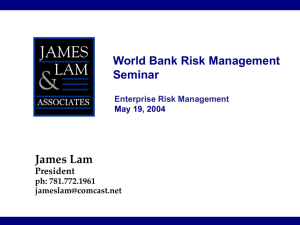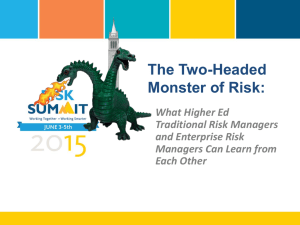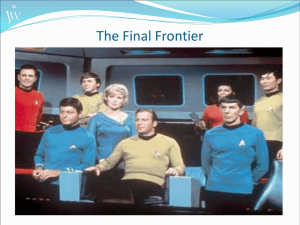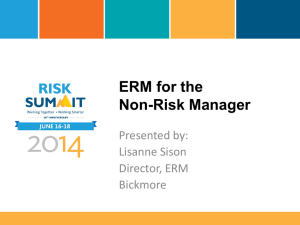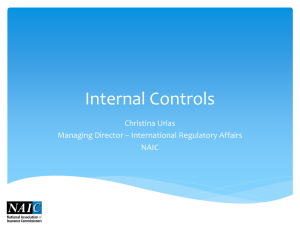—June 2005 issue Against the Grain
advertisement
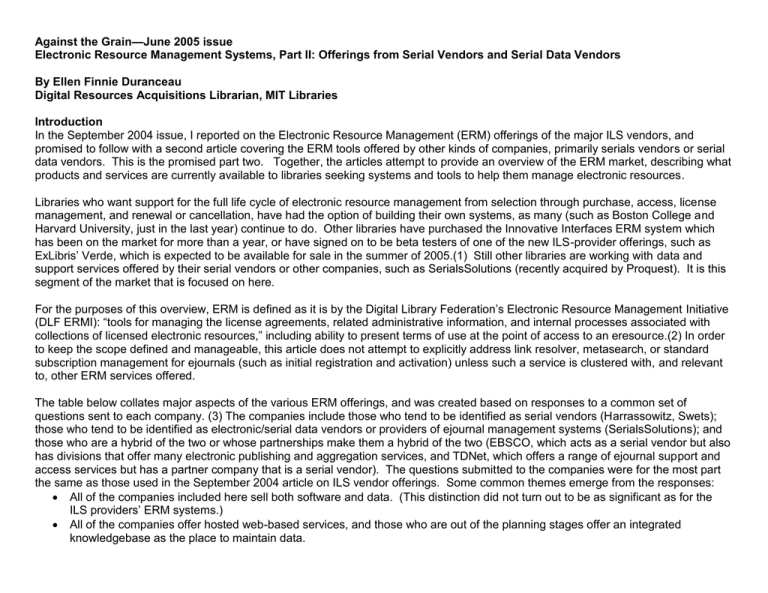
Against the Grain—June 2005 issue Electronic Resource Management Systems, Part II: Offerings from Serial Vendors and Serial Data Vendors By Ellen Finnie Duranceau Digital Resources Acquisitions Librarian, MIT Libraries Introduction In the September 2004 issue, I reported on the Electronic Resource Management (ERM) offerings of the major ILS vendors, and promised to follow with a second article covering the ERM tools offered by other kinds of companies, primarily serials vendors or serial data vendors. This is the promised part two. Together, the articles attempt to provide an overview of the ERM market, describing what products and services are currently available to libraries seeking systems and tools to help them manage electronic resources. Libraries who want support for the full life cycle of electronic resource management from selection through purchase, access, license management, and renewal or cancellation, have had the option of building their own systems, as many (such as Boston College and Harvard University, just in the last year) continue to do. Other libraries have purchased the Innovative Interfaces ERM system which has been on the market for more than a year, or have signed on to be beta testers of one of the new ILS-provider offerings, such as ExLibris’ Verde, which is expected to be available for sale in the summer of 2005.(1) Still other libraries are working with data and support services offered by their serial vendors or other companies, such as SerialsSolutions (recently acquired by Proquest). It is this segment of the market that is focused on here. For the purposes of this overview, ERM is defined as it is by the Digital Library Federation’s Electronic Resource Management Initiative (DLF ERMI): “tools for managing the license agreements, related administrative information, and internal processes associated with collections of licensed electronic resources,” including ability to present terms of use at the point of access to an eresource.(2) In order to keep the scope defined and manageable, this article does not attempt to explicitly address link resolver, metasearch, or standard subscription management for ejournals (such as initial registration and activation) unless such a service is clustered with, and relevant to, other ERM services offered. The table below collates major aspects of the various ERM offerings, and was created based on responses to a common set of questions sent to each company. (3) The companies include those who tend to be identified as serial vendors (Harrassowitz, Swets); those who tend to be identified as electronic/serial data vendors or providers of ejournal management systems (SerialsSolutions); and those who are a hybrid of the two or whose partnerships make them a hybrid of the two (EBSCO, which acts as a serial vendor but also has divisions that offer many electronic publishing and aggregation services, and TDNet, which offers a range of ejournal support and access services but has a partner company that is a serial vendor). The questions submitted to the companies were for the most part the same as those used in the September 2004 article on ILS vendor offerings. Some common themes emerge from the responses: All of the companies included here sell both software and data. (This distinction did not turn out to be as significant as for the ILS providers’ ERM systems.) All of the companies offer hosted web-based services, and those who are out of the planning stages offer an integrated knowledgebase as the place to maintain data. All of the companies have made an effort to follow and use the DLF ERMI guidelines, although the guidelines’ detailed coverage of license metadata does not appear to be as fully applied in these offerings as in the ILS-provider based systems. All of the companies have a means of integrating print and electronic holdings information for staff use; however, there is wide variation with respect to what can be displayed to the public end-user. Overview of ERM Systems From Serial Vendors and Serials Data Suppliers Vendor: EBSCO ERM Functionality availability; name of system Offer several services in which ERM is embedded, including: subscription services (with activation and registration, auditing packages, etc.); EBSCOhost Electronic Journals Service (with tools for managing activation and access, offering Admin Alerts and Authentication Helper); A-Z, an online collection management service (with package and aggregated title list management, proxy support, end user notes and icons feature); and LinkSource, an OpenURL link resolver (with integration of A-Z to provide item-level linking to library’s collection.) Harrassowitz Proquest SerialsSolutions “HERMIS” 3.0 “ERMS” [Harrassowitz SerialsSolutions’ Electronic Resource Electronic Management and Resource Information Management Solutions], a suite of System; first bundled services to version to be support libraries’ ereleased in July resources 2005. workflows. OttoSerials 3.0, a web-based serials management system, is an integral part of HERMIS. Examples of ERM support offered include online repository for signed licenses and a license status field, management of licenses, trials, activations, and usage statistics (with links to publshers’ sites and the ability to consolidate statistics from multiple publishers/ providers), including library order information, and ejournal profile information for a site, including IP ranges, subscriber IDs, and FTE Swets Provides a range of services for electronic resources: In addition to the customer service support for obtaining and accessing eresources, offers online access to DataswetsConnect, which details bibliographic, ordering and payment information for electronic titles, including package contents. Also have various modules on the market and in development, including SwetsWise Online Content (ejournal aggregation), SwetsWise Linker (OpenURL link resolver), SwetsWise Title Bank (A-Z listing), SwetsWise License Bank (license management), and eresource management reports (including Internet Availability Report). Primary strategy is to partner with eresource TDNet “TeRM” (TDNet Electronic Resources Manager) offers tools that provide and support ERM; available now. Standalone or Integrated into other product offerings? ERM is embedded in a range of services offered by EBSCO (see above). counts. It is not necessary to be a customer of Harrassowitz’s other services and products in order to use HERMIS, and ebooks can also be included along with serials. ERM tools are integrated into and are part of OttoSerials; they are enhancements of the traditional functionality of a subscription management system. Operates entirely independently of library’s ILS or library’s operating system. Does product include ERM data, ERM software, or both? Software and data. Software and data. providers, publishers, third part entities and libraries to gather the data in order to link with various ERM systems. ERMS is an enhancement of Access & Management suite, integrated into eresource knowledgebase and with hosted resource discovery tools such as Article Linker, Central Search, and Ejournal Portal. Software and data, including subscription metadata, license terms, resource management workflows, incident reports, and contact information, among other data. For bibliographic information, Swets has enhanced the eresource data in DataswetsConnect. All new e-resource modules sit on the same platform and older products, such as DataswetsConnect, are being moved to the same platform so it will be easy to integrate the functionalities or split them apart as necessary. Software and data. Customers can view the journals that are included in a package; offers options for management reports and invoicing to assist with tracking packages, as well as for automatically tracking the status of licenses; provides followup as needed. This internal license tracking system is the basis for SwetsWise License Bank. Software and data can be used as integrated suite, or customer can purchase data which can be used to populate another company’s offering. Software and data. Offers software, tools, and data that assist with package content tracking, access, and administration of data. Order and payment information offered from partner company, TELDAN, which offers journal subscription and order control. License management currently exists as text/notes information. This will be enhanced in future and integrated with acquisitions module. Operating system/platform/ Interface Web-based service. Hosted, web-based set of services. Hosted, web-based product, supports all common operating systems and platforms. Web-based GUI accessed via standard browsers; SwetsWise modules developed in a java environment and run on various operating systems. Platform sits on IBM's Websphere application. Web-based service, or data file sent in any recognized format. For web-based service, if hosted by TDNet, need only IE browser. If library or organization hosts on their intranet they need Microsoft OS Windows 200X and Microsoft SQL DB. Pricing Model A-Z and LinkSource are priced per unique title. Based on the number of fulltext journal holdings. Varies per SwetsWise module. Normally based on number of unique titles; but special pricing for consortia and multisite organizations. Will also offer FTE pricing. Customer Base Worldwide. Libraries of all sizes and types, from smallest special library to largest research library, worldwide. Worldwide; customers in 140 countries. Primarily focuses on the academic, government, medical and corporate markets. Used by libraries in 18 countries, including academic, government, medical, and corporate. Some customers use TeRM in lieu of ILS provided modules. Key Competitors Other serial agents. Two levels of service: Standard, which is available to all Harrassowitz subscription customers as part of service charge; and Advanced, available for a separate annual service charge. Price negotiated based on services provided. Developed primarily for libraries without staffing resources or expertise to manage their eresource subscriptions on their own and do not wish to invest in or maintain a locally hosted ERM system. HERMIS customers are largely North American, but also European. Other serial agents. ExLibris, Endeavor, Innovative Interfaces. Even though they are also competitors for the sale of an ERM module, many of the developers of ERM systems are Swets’ Ebsco, Serialssolutions, Local IT developers (at university or company), SFX “Elevator Speech” – Key distinguishing features “EBSCO acts as a middleman between libraries and publishers and even in the electronic world we feel our role is to add value to both; therefore, we have developed and are continuing to develop a range of services to help reduce the laborintensive tasks of acquiring, managing, and supporting eresources. To this end, EBSCO feels that we are maximizing the value we can offer our customers by incorporating a number of ERM features in the variety of services we offer our customers. ERM … [is] part of what we do, and not a separate module.” “HERMIS is a suite of services that includes ERM components. HERMIS services are designed to support all steps in the library’s ejournal workflow…[A]llows libraries to outsource the timeconsuming activities related to license negotiation and eresource activation. … Through its dataexport services, OttoSerials can assist with populating and maintaining other eresource-related systems, such as AZ lists, link resolvers, and public catalogs. The strength of HERMIS is in the integration of its parts: eresource management services, a prepopulated database of products and orders, and ERM “Empowers librarians to gain control over the complex and timeconsuming process of selecting, acquiring, and managing electronic resources…Tightly integrated resource discovery products, so a single change affects all of a library’s eresource access and management services. Built on foundation of SS knowledgebase to ensure accurate metatdata and enable a broad array of discovery and evaluation tools such as overlap analysis and usage statistics benchmarking. The hosted central data center… accessed through user-friendly web interface [means you]… don’t have to install or partners, or will be, as Swets is actively working with all major library automation systems to develop linking programs through EDI standards, with the goal of being able to link to all systems. “As a subscription agent, Swets excels to provide service to meet your electronic resource needs. You may need e-resource information in order to select the appropriate version of a title or an A-Z solution. We offer various e-resource management tools supported by our customer service… ERM and product management staff; all are certified for quality service under the ISO 9001-2000 standards. Our ongoing strategy is to partner and link with various ERM systems/modules in order to provide options for your eresource needs.” “TeRM focuses on the accuracy and completeness of the data with the most comprehensive and complete knowledgebase (now exceeding 100,000 titles). We solve the most critical problem of what truly exists in packages (aggregator or publisher). TDNet is an independent company…[which] has 20 years experience in providing integrated information solutions.” Architecture; Key organizing principle ERM functionality is a byproduct of a variety of EBSCO services with data being interchanged between. The main knowledgebase is centered on relationships between vendors, packages, eresources and holdings. The system is organized such that a vendor can have many packages, a package can have many resources, a resource can participate in many packages, and a resource within a package can have more than one set of coverage dates. Customers can manage notes (e.g. License terms for end-users) and proxy by vendor, package, and/or resource within a package. functionality. Unlike many products on the market, HERMIS functions closely with subscription management and combines both services and software.” HERMIS activities are advised by a library profile interacting with ERM data. There are 3 interconnected components: product database, order database, and library profile. All ERM data is related either to the product (e.g. included titles, coverage dates, providers, pricing, URLs, publisher licenses, etc.) or the library order (e.g. license status, scanned signed license, activation status, claims for access problems, renewal dates and ticklers, notifications of URL changes). Data can be organized by the product (combination or package) or individual title, or order, since all are linked. Title view brings together all possible versions of maintain software on site.” Based around a 3tiered hierarchy: content providers, databases, and journal holdings (or other content). This hierarchy is the fundamental building block that enables inheritance from one level to the next, a key feature for managing bibliographic access and licensing metadata with the least amount of data entry …at each level, authority records maintained by SS provide a way for libraries to describe and maintain their resource subscriptions… single journals can be collected together into one or more custom databases in order to maintain shared metadata about them as a collective In internal Swets system, records are built based on information supplied by the publisher, for example, a specific package is referred to by the name provided by the publisher. A group record is created that can be obtained from the member record. Eresource modules in SwetsWise carry this same philosophy and are built based on data from the internal system or provided by thirdparty entities. Knowledge base records are relational and include separate manifestations for license, resource, vendor, consortia (group relationships), access, and usage terms. For example, the License manifestation includes license details, user & site information, termination info, copying, redistribution, search, and other specifically identified license details. Integration with print for staff handling Print holdings and other formats can be integrated in the A-Z product. Can be grouped into collections. Integration with print for public end-user displays Print holdings and other formats can be integrated in the A-Z product. Support portal access/ A-Z list? There is no ERM with its own separate end-user interface, but the AZ list acts as the end-user interface. a particular title; combination view shows all versions of titles included in a particular combination. Both views are linked to library subscriptions. Eresources completely integrated with print and other formats. Underlying database contains all versions (print, electronic, combined P+E) of a title and collocates all the versions of title in display. Focus so far for HERMIS and OttoSerials has been on staff management of eresources rather than end-user functionality. Can provide libraryspecific access and coverage data for loading into another providers’ end-user system, such as an A-Z list or link resolver. Harrassowitz can also supply such systems through marketing arrangements with industry partners. purchase. Title authority system’s work level identifier allows all formats to be integrated in staff level view. In internal Swets System, staff are able to see the versions of a title - print, eresource, combination packages, etc. Allows for including print resources, with seamless integration. All formats will appear in same results record when end users search for a title. ERMS does not have its own interface, but user access is via tools such as SS portal, or through loading data into third party tools. SS portal is primary user interface; can also be exported for use in thirdparty applications, each holding as a separate line with details of URL, coverage, provider. A-Z list does not necessarily integrate print and electronic formats. Through SwetsWise Subscriptions, endusers within a corporation can view and order, if authorized, any version of a title. Customer decides if multiple formats display is integrated or fully integrated in the current A-Z list interface. An enhanced ERM interface for the end-user is under development. SwetsWise Title Bank, a separate module, can generate an A-Z list of ejournals which allows for either one title entry with multiple holdings statements indicating level of access for each entry, or multiple occurrences of the title with a single or Offers portal. Core of TeRM is the A-Z listing, offering single title with all manifestations from various suppliers, including print if customer prefers. Data Maintenance Visibility to users of license terms/rules of use EBSCO manages the underlying knowledgebase; customer does not have to maintain title lists, coverage, URLs, etc. Customer only has to select which packages they take. The A-to-Z list’s administrative module handles both fixed and selective packages. For selective packages, a customer chooses the titles from a list. Holdings for the A-Z list can be imported from an Excel spreadsheet (or tabdelimited or XML format), to integrate print collections or publisher title lists. A-Z listing can be used for all holdings, whether or not the title was acquired through EBSCO. MARC records are available as part of the A-Z With MARC service. A notes and icons feature allows the library to add appropriate flags or textual notes to a given resource. Notes and icons can HERMIS and OttoSerials are integrated with Harrassowitz’s entire knowledge base of serials information, prepopulated with data elements needed for ERM as received from publishers and other sources. For example, Ingenta and Highwire resources are already represented in the database. Data on titles in fulltext aggregators like ProQuest and EBSCOHost are not yet included. Product integrated into knowledgebase, used to manage holdings information in SS products but also in competitors’ products. Libraries need to maintain only local metadata fields; SS handles basic maintenance. License terms can be parsed and stored in OttoSerials, and these along with other user-related information are Terms of use can be displayed via Ejournal Portal, Article Linker, or 856 “view terms of use” links in MARC records updating multiple holdings statements. Management reports are being leveraged to upload information into ERM systems. Internet Availability Report (IAR) has been tested to load into ERM systems; other options are being explored. Our ongoing work with the ONIX standards will set the stage for further development. Under discussion and planning. Information is maintained by TeRM in knowledgebase; customer does not need to add or maintain records. Library has option to load records into OPAC and to receive weekly change files of added titles, URL changes, coverage changes. Records for OPAC can be CONSER or brief MARC records. Single text note is visible to end users; ultimately this will be presented when relevant. Software to include this kind of context sensitive response, unique user, Compliance with DLF guidelines be administered at the vendor level, the package or database level, or at the level of the individual resource within a package or database. The guidelines are used for input and will continue to influence future development. available to library staff. Terms could be exported to library’s end-user system. service. Note option also exists. DLF/ERMI work “invaluable in informing the development of HERMIS.” Used as the basis for definition of HERMIS services and specification of OttoSerials 3.0 functionality. Used whenever possible, especially for functionality that post-dates the guidelines, e.g. for licensing and terms of use. Going forward, will be used as a starting point for enhancements. and other appropriate rules is still under development. Has been involved from the beginning with the DLF initiative and continues to be involved. Is participating in the NISO/EDItEUR JWP Onix standards creation and are/will be utilizing those standards. TDNet ERM is based on the requirements of DLF ERMI; these guidelines were further complemented and enhanced by features based on data derived from TDNet statistics, subscription information, and other content management components in TDNet’s Journal Management service. Discussion The information in the table suggests some key distinguishing features among the offerings. In comparison with the ILS vendors, this group of companies offers a much wider range of approaches to the problem of supporting ERM, coming from their different perspectives. These different approaches are highlighted in response to the “elevator speech” question each vendor was asked: what they would say to distinguish their product from the competition if they had a five-floor elevator ride with a potential customer? EBSCO focuses on how they have integrated ERM seamlessly with other related services as an experienced middleman between libraries and publishers; Harrassowitz, also an experienced middleman, also emphasizes integration with subscription management, combining service and software, and supporting all steps in the library’s ejournal workflow; Swets mentions their partnerships with ERM systems and services, partnerships that emerge from and relate to their work as a serials agent; SerialsSolutions makes a special point about their hosted central data center meaning customers are not installing or maintaining software, streamlined data maintenance resulting from integrated tools, and the strength of their knowledgebase; and TDNet wants customers to know about their depth of experience, and the accuracy and completeness of data behind their ERM tools, especially related to package content. Timing of Availability EBSCO and TDNet have tools available now; SerialsSolutions has been selling data and package-comparison (“overlap analysis”) tools for some time, but will launch a more complete set of ERM software in July 2005; Harrassowitz has newly bundled ERM services and focused support and development in this area; Swets is still planning and designing its ERM offerings. Integration of ERM functions For the most part, in this group of providers, SerialsSolutions and TDNet have full ERM system offerings, while the other companies are developing and beginning to integrate access tools like A-Z listings and subscription support services but are not yet offering a single complete ERM system itself. The providers have all integrated ERM functions into some other aspect of library service, or plan to; this plays out differently, however, depending on what other services a company provides. For Proquest’s SerialsSolutions, ERM tools will be integrated into an eresource knowledgebase, along with linking, portal and search tools. SerialsSolutions is moving into a new stage and position in the marketplace; having offered data and some analysis tools for some time, they will now be supporting license management, contact information, and eresource workflow. For Harrassowitz and Swets, companies positioned primarily as serial subscription vendors, ERM-like services are beginning to be embedded in the subscription services, such as order management. Harrassowitz’s services allow for integration of title/package data purchased from a company like SerialsSolutions. TDNet also offers the flexibility of buying their integrated data and software, or using the TDNet tools with data purchased from another provider, and integrates their ERM services with link resolution and federated searching services. EBSCO integrates ERM with their serial subscription, A-Z listing, and link resolver services. In general, these companies seem to be responding to the universal need for integrated functions to support electronic resource purchase, management, and access, both by integrating their own offerings and making it possible to mix-and-match their offerings, to some extent, with those of other companies. While none of these companies offers a traditional catalog integrated with their ERM tools and data, most offer -- or plan to offer -- some kind of portal service to integrate access functionality. The exceptions include Harrassowitz, which does not actually offer such a tool themselves, but offers data to populate another provider’s portal, and Swets, which offers Swetswise for access to eresources but has not integrated this into other ERM tools yet. License Support and Display of License Terms The ability to code license terms and display them readily for both administration and access is a critical area for many libraries trying to manage their electronic collections. The companies’ products vary at this time with respect to depth of support for these processes. The products described here also vary significantly from the level of support offered by the ILS provider systems, all of which offer (or are designed to soon offer) the ability to encode extensive and highly granular metadata related to license terms. With the exception of SerialsSolutions, companies reviewed here do not generally offer a ready-made ability to display terms of use in the library catalog. SerialsSolutions seems to offer the most developed set of options for displaying license terms; terms can be encoded and displayed through their portal, article linker, or an option in their MARC record service (for use potentially in a library catalog) which allows end users to view terms of use. EBSCO’s offerings in this area will be enhanced; they offer notes and icons at this time. TDNet offers a single text note and is developing more context-sensitive capabilities for displaying license information. Harrassowitz allows for some license terms to be stored, but to display such terms to the public end user, a library would need to export them to the OPAC. Swets does not support license coding at this stage, and is still planning the degree of support for this area. Public End-User Access Although resource discovery was not focused on in this overview, it is important to know whether a company offers a tool accessible only to staff, or if the tool or data in the tools can be seen by public end users. Harrassowitz has focused solely on staff support for ERM, and is not offering a portal or access tool; Swets offers an A-Z listing as a separate module; the others, including EBSCO, TDNet, and SerialsSolutions, integrate ERM with portal services or A-Z listings that are intended as primary end-user access tools. Coverage of Aggregators and Ebooks Harrassowitz can handle ebooks and (like the other companies, aside from Swets, where it is not determined) titles purchased through any serial vendor, but Harrassowitz’s and Swets’ (apparent) current lack of access to title-level data for the fulltext article aggregators like Proquest and EBSCOhost is a significant difference libraries should be aware of. The other companies can offer libraries title level data about the contents of these aggregators, which for many libraries is an important service -- one they simply cannot manage on their own. Conclusion The ERM market has exploded in the past two years, and now offers a variety of players and options. Libraries can mix and match services between ILS modules intended for electronic product management, data services that can populate such modules, and/or a library’s own portal; or they can turn to their serial vendors (or serial data vendors) for added services and support in this area, without themselves managing a database or portal of their own. This overview of the non-ILS providers of ERM services points to a diverse set of offerings now on the market, which range, at the simplest level, from enhanced subscription support for ejournals, along with some basic reporting or listing/access tools for eresources (such as those offered by the two serial vendors here, Harrassowitz and Swets) to systems that are closer in their range of functionality and deep support for license management to the full-service, ILS-based ERM modules discussed in part one of this overview (such as SerialsSolutions and TDNet.) A library will need to think deeply and broadly about what kind of services they want to offer, and consider what resources they have internally to devote to such services, before choosing a path. Some of the likely scenarios (which are not mutually exclusive) include: Asking a serial vendor to enhance service offerings to help support the activation and maintenance of electronic serials, primarily to aid the library staff; Paying a company like TDNet or SerialsSolutions to manage and host every aspect of electronic resources, from listing the titles for public end users in an A-Z list, keeping track of package contents, and allowing library staff a means of encoding some license terms; Taking eresource data from one provider, such as SerialsSolutions or TDNet, and using it to populate a library’s own locally managed tools, such as a portal, an OPAC, a customized third-party provider’s A-Z list, or even a full home-grown ERM;(4) Continuing to invest in access through the OPAC by using an ERM from the library’s ILS provider that can interoperate with the OPAC (and possibly purchase eresource data from the ILS provider, as well, depending on whether the ILS provider offers this service), or by integrating a third party’s eresource data (such as TDNet or SerialsSolutions) into the OPAC. The full array of options is somewhat overwhelming -- to use one of my witty colleague Rich Wenger’s best lines, in thinking about all of the possible scenarios, “my imagination hurts.” Nevertheless, the library community should be pleased that we have so many methods and options available to us now to support electronic resource management. In the face of such diverse options, though, one challenge to libraries is to sufficiently understand local needs and capabilities, as well as the fertile and complex market growing up around us, so as to be able to map the two together and come up with the best set of services for our staffs and communities. This two-part overview of the ERM marketplace is only a snapshot of a rapidly moving target, but the hope is that it will offer a starting point for libraries who are beginning to do this kind mapping of needs to options by investigating the ERM services, tools, and support that are now available. And we should not forget, in evaluating the dizzying array of choices, that we also need to continue to advocate about our needs for managing digital resources, and to invest time and energy in the work on industry standards and guidelines for ERM, an investment that offers hope for increased efficiencies and flexibility in the future. Notes 1 MIT was a codevelopment partner for ExLibris’ Verde system but has not yet made a decision about whether or when to adopt it. 2 For more information on these guidelines see: http://www.diglib.org/standards/dlf-erm02.htm. 3 A Special thanks to the following individuals for taking the time to contribute responses for this article, some of them on short notice: Jeff Aipperspach and Tina Feick, Swets Kathy Klemperer and Knut Dorn, Harrassowitz Michael Markwith, TDNet Oliver Pesch, EBSCO Mike Showalter, SerialsSolutions (Proquest) 4 For a list and description of homegrown tools, see: the information under “Local e-Resource Management Systems“ at: http://www.library.cornell.edu/cts/elicensestudy/home.html. This site also offers updates on the commercial ERM systems.


